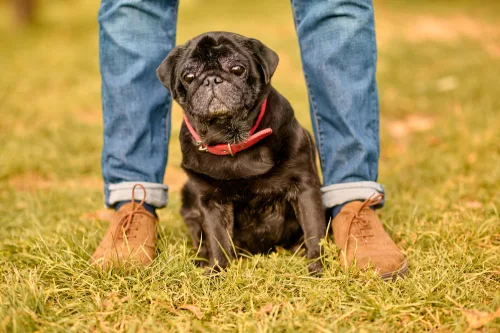How to make a constipated dog poop quickly?
What to Do If Your Dog Can’t Poop? How to Make a Dog Poop Quickly?
If your dog is constipated and you’re looking for ways to help them relieve it, there are several safe and effective strategies you can try:
1. Hydration
- Ensure your dog is drinking plenty of fresh water. Dehydration can contribute to constipation.
- Adding water to their dry food or giving them ice cubes to lick can also help increase their fluid intake.
2. Increase Fiber Intake
- Canned pumpkin: 100% pure canned pumpkin (not the pie filling) is rich in fiber and can help stimulate bowel movements. Add 1-2 tablespoons to your dog’s food.
- Bran or oat fiber: You can also mix a small amount of wheat bran or oat fiber into their meals.
- High-fiber dog food: Switching to a food with more fiber might help regulate bowel movements.
3. Exercise
- Regular physical activity, such as walking or playing, can stimulate your dog’s digestive system and help get things moving. Try taking your dog for a brisk walk.
4. Massage
- Gently massaging your dog’s abdomen in a circular motion can help stimulate the digestive system and encourage a bowel movement.
5. Olive Oil or Coconut Oil
- Adding a small amount (about a teaspoon) of olive or coconut oil to your dog’s food can lubricate the digestive system and help relieve constipation.
6. Milk
- Some dogs are lactose intolerant, so a small amount of milk (around a tablespoon) can stimulate a bowel movement. However, use this sparingly and only if you know your dog can tolerate it.
7. Veterinary-Approved Stool Softener
- There are over-the-counter stool softeners for dogs, but it’s important to consult your vet before giving any medication to your dog.
8. Vet Visit
- If your dog hasn’t pooped in over 48 hours or seems to be in pain, it’s time to visit the vet. There could be an underlying issue, such as a blockage or an illness.
Important: Avoid giving human laxatives to your dog unless specifically instructed by your vet, as these can be dangerous for animals.
How dog poop scoop service cost?
The cost of a dog poop scoop service can vary based on several factors, including location, frequency of service, the number of dogs, and the size of your yard. Here’s a general breakdown of costs:
1. Average Cost Per Visit
- $10 to $20 per visit for a standard-sized yard and one dog.
- For multiple dogs, the price might increase by around $3 to $10 per additional dog.
2. Frequency of Service
- Once a week: Typically, services charge around $10 to $20 per week for one dog.
- Twice a week: This might cost around $15 to $30 per week.
- Bi-weekly or monthly services are less common but might be cheaper per visit.
3. Yard Size
- If you have a large yard, it could add a small additional fee (e.g., $5 to $10 more per visit).
4. Special Services
- Initial cleaning (if the yard hasn’t been cleaned in a while) might cost more, often around $40 to $80, depending on the level of buildup.
- Some companies also offer additional services, like deodorizing the yard, which might add $5 to $15 per visit.
5. Discounts
- Many companies offer discounts for long-term contracts (monthly, bi-monthly) or referrals.
Prices of dog poop scoop service can differ by region, so checking with local providers for exact costs is a good idea.
What is the Constipation of a dog?
Constipation in dogs refers to a condition where a dog has difficulty passing stools or has infrequent bowel movements. It happens when the digestive system slows down, making it hard for the dog to defecate. Constipation is typically characterized by small, hard, dry stools or a complete inability to pass stool, often accompanied by straining or discomfort.
Signs of Constipation in Dogs:
- Straining: The dog may crouch or hunch, trying to defecate but without success or with little result.
- Small, Hard Stools: When the dog does manage to pass stool, it may be small, dry, and hard.
- Decreased Frequency: The dog may go longer than usual between bowel movements.
- Discomfort: A constipated dog may seem uncomfortable, often pacing, whining, or showing signs of abdominal discomfort.
- Lethargy: In more severe cases, the dog may be lethargic or lack interest in food and activities.
- Scooting: Dogs might drag their bottom on the ground due to discomfort.
Causes of Constipation in Dogs:
- Dehydration: Insufficient water intake can lead to hard, dry stools.
- Diet: Low-fiber diets, eating too much bone (in raw diets), or consuming indigestible materials like hair, dirt, or grass can cause constipation.
- Lack of Exercise: Physical activity helps stimulate the digestive system, so a sedentary lifestyle may contribute to constipation.
- Medical Conditions:
- Obstruction: Blockages in the intestines from foreign objects, tumors, or hair.
- Enlarged Prostate: In male dogs, an enlarged prostate can press on the colon, making it difficult to pass stools.
- Spinal or Neurological Issues: Damage to the spine or nerves can disrupt the signals that control bowel movements.
- Pain or Discomfort: Conditions like arthritis, hip dysplasia, or back problems may make it painful for a dog to squat, leading to constipation.
- Medications: Certain medications, such as painkillers, antihistamines, or diuretics, may slow down the digestive system.
- Age: Older dogs are more prone to constipation due to slower digestion, less activity, and other age-related issues.
Complications of Untreated Constipation:
If constipation isn’t treated, it can lead to obstipation, a more severe condition where the stool becomes impacted, and the dog is unable to pass any stool at all. This can cause serious health problems, including:
- Megacolon: Chronic constipation can stretch the colon, leading to megacolon, where the colon loses its ability to contract properly.
- Intestinal Blockage: If stool builds up, it can block the intestines, requiring medical intervention.
- Toxemia: Severe constipation can lead to the buildup of toxins in the body, making the dog very ill.
When to See a Vet:
If your dog hasn’t pooped in more than 48 hours, or if they show signs of pain, bloating, vomiting, or lethargy, it’s important to contact a vet. Persistent constipation may indicate an underlying health issue that needs medical attention.
What is the Treatment for Dog Constipation?
Treating constipation in dogs typically involves a combination of dietary adjustments, lifestyle changes, and sometimes medication, depending on the underlying cause. Here’s a breakdown of common treatments:
1. Hydration
- Increase Water Intake: Ensure your dog has constant access to fresh water. Dehydration is a common cause of constipation, so making sure your dog drinks enough water can help soften stools.
- Wet Food: Switching to wet dog food or adding water to dry kibble can help increase moisture in your dog’s diet.
2. Dietary Adjustments
- Canned Pumpkin: Pure canned pumpkin (not the spiced pie filling) is high in fiber and can help regulate bowel movements. Add 1–2 tablespoons to your dog’s food, depending on their size.
- High-Fiber Diet: Increasing dietary fiber can promote healthier bowel movements. You can either switch to high-fiber dog food or add fiber supplements like bran or psyllium husk (with vet guidance).
- Vegetables: Adding small amounts of fiber-rich vegetables, like carrots or green beans, can help.
3. Exercise
- Regular physical activity stimulates the digestive system and encourages bowel movements. If your dog is constipated, increasing their daily exercise, such as longer walks or more playtime, may help.
4. Laxatives or Stool Softeners
- Over-the-Counter Stool Softeners: Under veterinary guidance, products like Miralax (polyethylene glycol) or Docusate Sodium can be given to soften stools. Always consult your vet for the correct dosage based on your dog’s weight and condition.
- Lactulose: This is another stool softener that your vet may prescribe. It works by drawing water into the colon, helping to soften the stool.
5. Lubrication
- Olive or Coconut Oil: Adding a small amount (1 teaspoon for small dogs, 1 tablespoon for large dogs) of olive or coconut oil to your dog’s food can lubricate their digestive system and help move stools along.
6. Enema
- In more severe cases of constipation, a vet may perform an enema to help flush out the stool. This should only be done by a professional, as incorrect administration can cause injury or complications.
7. Medication Adjustments
- If constipation is a side effect of a medication your dog is taking, consult your vet to discuss alternatives or dosage adjustments.
8. Treatment for Underlying Conditions
- If your dog’s constipation is due to an underlying health issue, like an enlarged prostate, spinal injury, or megacolon, your vet will need to treat the specific condition to resolve the constipation.
9. Surgery (in Severe Cases)
- If there is a blockage in your dog’s intestines, surgery may be necessary to remove the obstruction. This is a last-resort treatment used in life-threatening situations.
10. Preventive Measures
- Regular Hydration: Keep your dog well-hydrated at all times.
- Balanced Diet: Feed your dog a balanced diet that includes sufficient fiber.
- Routine Exercise: Keep your dog active to promote healthy digestion.
- Avoid Indigestible Items: Prevent your dog from eating foreign objects, like bones, toys, or other non-food items that could cause constipation or blockages.
When to See the Vet
If your dog hasn’t had a bowel movement for more than 48 hours, shows signs of pain, bloating, or discomfort, or if home remedies aren’t effective, it’s important to visit a vet. Severe or prolonged constipation can be a symptom of more serious health problems, such as an intestinal obstruction, and requires medical attention.
By consulting with your vet and following these treatments, you can often resolve your dog’s constipation effectively.
Can You Give a Dog Laxatives?
Yes, you can give a dog laxatives, but only under the guidance of a veterinarian. Not all human laxatives are safe for dogs, and improper use can cause serious harm, such as dehydration, electrolyte imbalances, or damage to the intestines. Always consult with your vet before administering any medication to your dog.
Can You Give a Dog an Enema?
Yes, you can give a dog an enema, but it should only be done under the guidance of a veterinarian. Administering an enema incorrectly can cause serious harm, including injury to the rectum or intestines, and even life-threatening complications such as perforation of the bowel.
When a Dog Might Need an Enema
Enemas are typically used when a dog suffers from severe constipation or obstipation (a more serious form of constipation where the stool is completely impacted). An enema helps by softening and loosening the stool, allowing it to pass more easily.
How Enemas Work
An enema involves introducing liquid into the dog’s rectum and colon to stimulate a bowel movement. The liquid softens the stool and adds moisture, making it easier to expel.
How long can dogs go without pooping?
Dogs can typically go 24 to 48 hours without pooping without any major concerns, especially if their diet or routine has recently changed. However, if a dog hasn’t pooped in more than 48 hours, it may be a sign of constipation or an underlying health issue that needs to be addressed.
General Guidelines:
- Normal Bowel Movements: Most dogs have 1 to 2 bowel movements per day, though this can vary based on their diet, activity level, and individual metabolism.
- 48 Hours: If your dog hasn’t pooped in this timeframe, it’s worth monitoring them closely for any signs of discomfort, such as straining, bloating, or lethargy.
- More than 48 Hours: If your dog hasn’t pooped for more than 2 days, it could be due to constipation, dietary changes, dehydration, or even an obstruction. It’s recommended to consult a veterinarian at this point.
What do I feed a constipated dog?
If your dog is constipated, feeding the right types of foods can help promote regular bowel movements. Here are some effective options to help alleviate constipation:
- Canned pumpkin
- High-fiber foods
- Canned dog food
- Olive oil or coconut oil
- Psyllium husk
- Watermelon or other watery fruits
- bone broth
- Milk
- Increase water intake
Veterinary Consultation:
If your dog remains constipated after dietary changes, or if constipation lasts more than 48 hours, consult your vet. They may recommend a stool softener, laxative, or additional treatments depending on the severity of the constipation.
With the right dietary adjustments, you can usually help relieve mild constipation in dogs. Make sure your dog stays hydrated and maintains a balanced diet to promote healthy bowel movements.
How many times a day should a dog poop?
The number of times a dog should poop per day can vary based on several factors, such as age, diet, activity level, and health. However, most dogs poop 1 to 2 times a day. Some dogs may go up to 3 times a day, and that can still be considered normal.
Factors Influencing How Often Dogs Poop:
- Diet:
- High-Fiber Diet: Dogs on high-fiber diets may poop more frequently because fiber adds bulk to the stool.
- Wet Food vs. Dry Food: Dogs eating wet food may have more frequent or softer stools compared to those eating dry kibble.
- Age:
- Puppies: Puppies often poop more frequently, usually 3 to 5 times a day, due to their smaller digestive systems and faster metabolism.
- Adult Dogs: Most healthy adult dogs poop 1 to 2 times a day.
- Senior Dogs: Older dogs may poop less often due to slower metabolism and changes in diet.
- Exercise and Activity:
- Regular exercise stimulates digestion, so active dogs might poop more frequently than less active dogs.
- Health:
- Dogs with gastrointestinal issues, changes in diet, or stress might poop more or less than usual.
- Constipation: A dog might poop less frequently or strain if constipated.
- Diarrhea: A dog may poop more frequently with looser stools if they have digestive upset or diarrhea.
What’s Considered Normal:
- 1 to 2 times a day is typical for most adult dogs.
- Up to 3 times a day can still be normal, especially for puppies or dogs on a high-fiber diet.
- Less than once a day may indicate constipation or other digestive issues and should be monitored.
- More than 4 times a day could suggest digestive upset, dietary intolerance, or a medical condition.
If your dog’s bowel movements are regular and consistent in frequency, and the stool is well-formed and healthy-looking, their routine is likely normal. However, if there are sudden changes in your dog’s poop frequency or consistency, it might be worth consulting with a vet.

How long for dog to digest food and poop? Image by zinkevych on Freepik
How long for dog to digest food and poop?
The time it takes for a dog to digest food and have a bowel movement can vary based on several factors, including the dog’s age, size, diet, and overall health. However, on average, the digestion process for dogs generally takes about 6 to 8 hours after eating, with a bowel movement usually occurring within 12 to 24 hours after a meal.
Factors Affecting Digestion Time:
- Type of Food:
- Dry Food (Kibble): Typically takes longer to digest compared to wet food because it has a lower moisture content.
- Wet Food: Generally digests more quickly due to higher moisture levels, leading to faster passage through the digestive tract.
- High-Fiber Foods: Foods high in fiber can speed up digestion but may also lead to more frequent bowel movements.
- Size and Breed:
- Small Breeds: Smaller dogs may digest food more quickly than larger breeds due to their faster metabolism.
- Large Breeds: Larger dogs might take longer to digest their food.
- Age:
- Puppies: Typically digest food faster than adult dogs due to their higher metabolism and growth needs.
- Senior Dogs: Older dogs may have slower digestion due to decreased metabolic rate or health issues.
- Activity Level:
- Regular exercise stimulates digestion, potentially leading to quicker bowel movements. Inactive dogs may have slower digestion.
- Health Status:
- Dogs with digestive issues or underlying health conditions may experience slower or disrupted digestion, leading to changes in the timing of bowel movements.
General Timeline:
- Initial Digestion: 6 to 8 hours after eating, the food begins to move through the stomach and into the intestines.
- Bowel Movement: Within 12 to 24 hours after a meal, a healthy dog will typically have a bowel movement, assuming normal digestion.
When to Be Concerned:
- If your dog hasn’t pooped within 24 to 48 hours after eating, it may indicate constipation or other digestive issues. It’s a good idea to monitor your dog’s behavior and stool consistency during this time.
- Sudden changes in bowel movement frequency or consistency, along with other symptoms like vomiting, lethargy, or abdominal pain, should prompt a visit to the vet.
Overall, understanding your dog’s normal digestion and bowel habits is important for maintaining their health. If you notice any concerning changes, don’t hesitate to consult your veterinarian.
Why does my dog poop so much?
If your dog is pooping more than usual, it could be due to several factors, ranging from diet to health issues. Here are some common reasons why your dog might be experiencing increased bowel movements:
1. Diet Changes
- High-Fiber Foods: A diet rich in fiber can lead to more frequent bowel movements. If you’ve recently switched to a higher fiber food or are feeding them more fruits and vegetables, this could be the cause.
- Wet Food vs. Dry Food: Switching to wet food, which contains more moisture, can also lead to more frequent stools.
- Sudden Dietary Changes: Rapid changes in diet can upset your dog’s digestive system, resulting in more frequent pooping.
2. Overeating
- Excessive Food Intake: If your dog is eating more than usual—whether due to increased portion sizes or additional treats—they may have more frequent bowel movements as a result.
3. Food Intolerance or Allergies
- Sensitivity: Dogs can develop sensitivities or allergies to certain ingredients in their food. This can lead to gastrointestinal upset, causing more frequent stools.
- Food Additives: Ingredients like artificial colors, flavors, or preservatives can irritate the digestive system in some dogs.
4. Stress or Anxiety
- Environmental Changes: Changes in the environment (like moving homes, new pets, or changes in routine) can lead to stress, which may affect your dog’s bowel habits.
5. Parasites
- Worms or Other Parasites: Conditions like intestinal worms (e.g., roundworms, hookworms) can lead to increased bowel movements, often accompanied by other symptoms like diarrhea, weight loss, or a bloated abdomen.
6. Gastrointestinal Disorders
- Inflammatory Bowel Disease (IBD): Conditions that affect the intestines can cause frequent diarrhea and increased stool production.
- Infections: Bacterial or viral infections can lead to increased stool frequency, often accompanied by diarrhea.
7. Medications
- Certain medications, especially antibiotics or medications affecting gut motility, can lead to changes in bowel habits.
8. Health Conditions
- Thyroid Issues: Conditions like hyperthyroidism can increase metabolism and lead to more frequent bowel movements.
- Diabetes or Cushing’s Disease: These endocrine disorders can cause increased urination and potentially more frequent defecation as well.
When to See a Vet
You should consult your veterinarian if:
- Your dog’s stool is watery or has changed in consistency (diarrhea).
- There are any signs of distress, such as vomiting, lethargy, or abdominal pain.
- Your dog is experiencing weight loss or has a decreased appetite.
- The increased frequency of bowel movements persists for more than a couple of days.
Overall, while some dogs may naturally have more frequent bowel movements, sudden changes in their patterns can indicate an underlying issue. Keeping track of your dog’s eating habits, behaviors, and any other symptoms can help your vet diagnose the problem more accurately.








